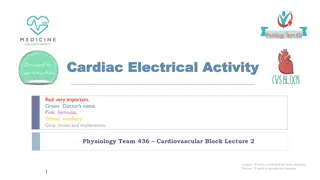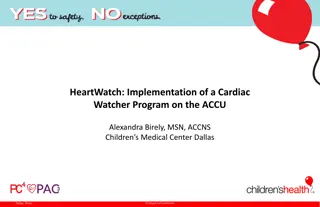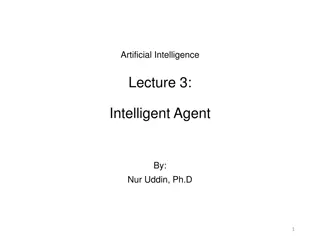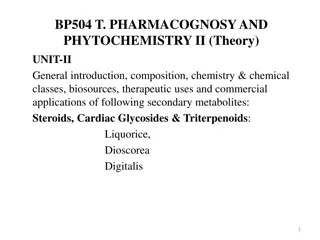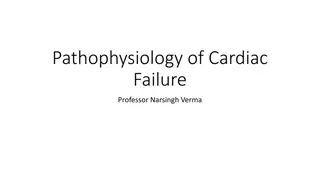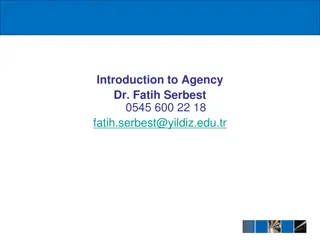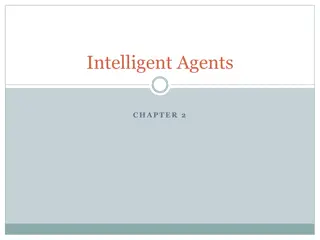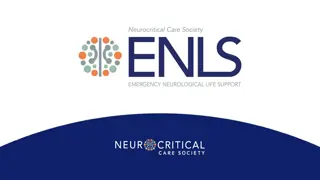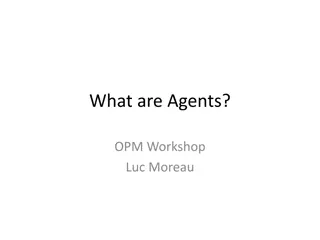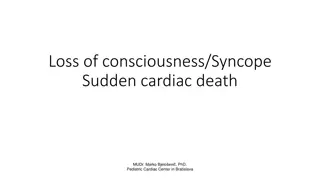Understanding Anti-Arrhythmic Agents in Cardiac Care
Anti-arrhythmic agents are crucial in managing abnormal heart rhythms like atrial fibrillation and ventricular tachycardia. Causes of arrhythmias vary from heart anatomy changes to medication side effects. Factors like exertion, imbalances in blood chemistry, and medication use can trigger arrhythmias. Proper diagnosis through tests like electrocardiograms helps in appropriate treatment with anti-arrhythmic drugs or medical procedures.
Download Presentation

Please find below an Image/Link to download the presentation.
The content on the website is provided AS IS for your information and personal use only. It may not be sold, licensed, or shared on other websites without obtaining consent from the author. Download presentation by click this link. If you encounter any issues during the download, it is possible that the publisher has removed the file from their server.
E N D
Presentation Transcript
ANTI ARRHYTHMIC AGENTS ANTI ARRHYTHMIC AGENTS Mrs.SASHMITHA SAMUEL M.Pharm. (Ph.D.) Associate Professor DEPARTMENT OF PHARMACEUTICAL CHEMISTRY
INTRODUCTION INTRODUCTION Also known as cardiac dysrhythmia medications. These are the drugs that are used to suppress abnormal rhythms of the heart, such as atrial fibrillation, atrial flutter, ventricular tachycardia, and ventricular fibrillation. Arrhythmia refers to improper beating of the heart, whether irregular, too fast or too slow. When a heart beats too fast, the condition is called tachycardia. When a heart beats too slowly, the condition is called bradycardia. DEPARTMENT OF PHARMACEUTICAL CHEMISTRY
Causes: Changes to the heart s anatomy Reduced blood flow to the heart or damage to the heart s electrical system Stiffening of the heart tissue, known as fibrosis, or scarring These changes can be caused by damage from disease, injury, or genetics. Symptoms if present, may include: Pain - chest Whole body - dizziness, fainting, or light-headedness Heart - palpitations or slow heart rate Also commonly - shortness of breath DEPARTMENT OF PHARMACEUTICAL CHEMISTRY
Exertion or strain Strong emotional stress, anxiety, anger, pain, or a sudden surprise can make the heart work harder, raise blood pressure, and release stress hormones. Sometimes these reactions can lead to arrhythmias. Excessive physical activity can trigger arrhythmia due to an excess of hormones such as adrenaline. Sometimes vomiting or coughing can trigger arrhythmia. Imbalances in blood An excess or deficiency of electrolytes, hormones, or fluids can alter your heartbeat. An excess of thyroid hormone can cause the heart to beat faster, and thyroid deficiency can slow your heart rate. Dehydration can cause the heart to race. Low blood sugar, from an eating disorder or insulin doses that are too high in someone who has diabetes, can lead to slow or extra heartbeats. Low levels of potassium, magnesium, or calcium can trigger arrhythmia. These electrolyte disturbances can occur after a heart attack or surgery. DEPARTMENT OF PHARMACEUTICAL CHEMISTRY
Medications Certain medicines can cause arrhythmia. These include medicines to treat high blood pressure and other conditions, including depression, and psychosis. Some people also need to be careful about taking certain antibiotics and over-the-counter medicines, such as allergy and cold medicines. Disorders of electrical signals An arrhythmia can occur if the electrical signals that control the heartbeat are delayed or blocked. This can happen when the nerve cells that produce electrical signals do not work properly or when the electrical signals do not travel normally through the heart. Another part of the heart could start to produce electrical signals, disrupting a normal heartbeat. DEPARTMENT OF PHARMACEUTICAL CHEMISTRY
The most common test used to diagnose an arrhythmia is an electrocardiogram. If required, treatment includes anti-arrhythmic drugs, medical procedures, implantable devices and surgery. The ultimate goal of antiarrhythmic drug therapy is to restore normal rhythm and conduction. When it is not possible to revert to normal sinus rhythm, drugs may be used to prevent more serious and possibly lethal arrhythmias from occurring. DEPARTMENT OF PHARMACEUTICAL CHEMISTRY
TYPES OF ARRHYTHMIAS Arrhythmias differ from normal heartbeats in speed or rhythm. Arrhythmias are also grouped by where they occur-in the upper chambers of the heart, in its lower chambers, or between the chambers. The main types of arrhythmia are 1. Bradyarrhythmias premature or extra beats 2. Supraventricular arrhythmias 3. Ventricular arrhythmias DEPARTMENT OF PHARMACEUTICAL CHEMISTRY
BRADYARRHYTHMIA Slow heart rate, also called bradycardia. For adults, bradycardia is often defined as a heart rate that is slower than 60 beats per minute. Some people, especially people who are young or physically fit, may normally have slow heart rates. A premature heartbeat happens when the signal to beat comes early. It can feel like your heart skipped a beat. The premature, or extra, heartbeat creates a short pause, which is followed by a stronger beat when your heart returns to its regular rhythm. These extra heartbeats are the most common type of arrhythmia. They are called ectopic heartbeats and can trigger other arrhythmias. DEPARTMENT OF PHARMACEUTICAL CHEMISTRY
SUPRAVENTRICULAR ARRHYTHMIAS Arrhythmias that start in the heart s upper chambers, called the atrium, or at the gateway to the lower chambers are called supraventricular arrhythmias. These are known by their fast heart rates, or tachycardia. Tachycardia occurs when the heart, at rest, goes above 100 beats per minute. The fast pace is sometimes paired with an uneven heart rhythm. Sometimes the upper and lower chambers beat at different rates. Types of supraventricular arrhythmias include: 1. Atrial fibrillation This is one of the most common types of arrhythmia. The heart can race at more than 400 beats per minute. DEPARTMENT OF PHARMACEUTICAL CHEMISTRY
2. Atrial flutter Atrial flutter can cause the upper chambers to beat 250 to 350 times per minute. The signal that tells the upper chambers to beat may be disrupted when it encounters damaged tissue, such as a scar. The signal may find an alternate path, creating a loop that causes the upper chamber to beat repeatedly. Some but not all of these signals travel to the lower chambers. As a result, the upper chambers and lower chambers beat at different rates. 3. Paroxysmal supraventricular tachycardia (PSVT) Electrical signals that begin in the upper chambers and travel to the lower chambers cause extra heartbeats. This arrhythmia begins and ends suddenly. It can happen during vigorous physical activity. It is usually not dangerous and tends to occur in young people. DEPARTMENT OF PHARMACEUTICAL CHEMISTRY
VENTRICULAR ARRHYTHMIA These arrhythmias start in the heart s lower chambers. They can be very dangerous and usually require medical care immediately. 1. Ventricular tachycardia It is a fast, regular beating of the ventricles that may last for only a few seconds or for much longer. Episodes that last for more than a few seconds can be dangerous. Ventricular tachycardia can turn into other more serious arrhythmias, such as ventricular fibrillation, or v-fib. Torsades de pointes is a type of arrhythmia that causes a unique pattern on an EKG and often leads to v-fib. DEPARTMENT OF PHARMACEUTICAL CHEMISTRY
2. Ventricular fibrillation Occurs if disorganized electrical signals make the ventricles quiver instead of pumping normally. Without the ventricles pumping blood to the body, sudden cardiac arrest and death can occur within a few minutes. DEPARTMENT OF PHARMACEUTICAL CHEMISTRY
Antiarrhythmic drugs are used to: decrease or increase conduction velocity alter the excitability of cardiac cells by changing the duration of the effective refractory period suppress abnormal automaticity All antiarrhythmic drugs directly or indirectly alter membrane ion conductance, which in turn alters the physical characteristics of cardiac action potentials. DEPARTMENT OF PHARMACEUTICAL CHEMISTRY
CLASSIFICATION Class I - Sodium-channel blockers. Class II - Beta-blockers. Class III - Potassium-channel blockers. Class IV - Calcium-channel blockers. Miscellaneous - adenosine - electrolyte supplement (magnesium and potassium salts) - digitalis compounds (cardiac glycosides) DEPARTMENT OF PHARMACEUTICAL CHEMISTRY
Class I - Sodium-channel blockers Sodium-channel blockers may also alter the action potential duration (APD) and effective refractory period (ERP). These effects on ERP are not directly related to sodium channel blockade, but instead are related to drug actions on potassium channels involved in phase 3 repolarization of action potentials. These channels regulate potassium efflux from the cell (K+out), and therefore repolarization. DEPARTMENT OF PHARMACEUTICAL CHEMISTRY
The Vaughan-Williams classification of subclasses of Class I antiarrhythmic drugs is as follows: Class IA - increase the ERP Class IB- while others decrease the ERP Class IC- have no effect on ERP DEPARTMENT OF PHARMACEUTICAL CHEMISTRY
QUINIDINE SULPHATE An optical isomer of quinine, extracted from the bark of the Cinchona tree and similar plant species. This alkaloid dampens the excitability of cardiac and skeletal muscles by blocking sodium and potassium currents across cellular membranes. It prolongs cellular action potential, and decreases automaticity. Quinidine also blocks muscarinic and alpha-adrenergic neurotransmission. DEPARTMENT OF PHARMACEUTICAL CHEMISTRY
It acts on sodium channels on the neuronal cell membrane, limiting the spread of seizure activity and reducing seizure propagation. The antiarrhythmic actions are mediated through effects on sodium channels in Purkinje fibers. DISOPYRAMIDE PHOSPHATE Interferes directly with the depolarization of the cardiac membrane and thus serves as a membrane-stabilizing agent) with a depressant action on the heart similar to that of guanidine. DEPARTMENT OF PHARMACEUTICAL CHEMISTRY
It also possesses some anticholinergic and local anesthetic properties. Disopyramide is indicated for the treatment of documented ventricular arrhythmias, such as sustained ventricular tachycardia that are life-threatening. PROCAINAMIDE HYDROCHLORIDE A derivative of procaine with less CNS action. DEPARTMENT OF PHARMACEUTICAL CHEMISTRY
Procainamide is sodium channel blocker. It stabilizes the neuronal membrane by inhibiting the ionic fluxes required for the initiation and conduction of impulses thereby effecting local anesthetic action. It is used for the treatment of life-threatening ventricular arrhythmias. PHENYTOIN SODIUM It is a hydantoin derivative. Phenytoin is often described as a non-specific sodium channel blocker. Targets almost all voltage-gated sodium channel subtypes. DEPARTMENT OF PHARMACEUTICAL CHEMISTRY
LIDOCAINE HYDROCHLORIDE Lidocaine is also considered a class IB anti-arrhythmic agent. It ultimately elicits its numbing activity by blocking sodium channels so that the neurons of local tissues that have the medication applied on are transiently incapable of signalling the brain regarding sensations. This may block or decrease muscle contractility, resulting in effects like vasodilation, hypotension, and irregular heart rate. DEPARTMENT OF PHARMACEUTICAL CHEMISTRY
TOCAINIDE HYDROCHLORIDE It is a primary amine analog of lidocaine. It acts on sodium channels on the neuronal cell membrane, limiting the spread of seizure activity and reducing seizure propagation. It binds preferentially to the inactive state of the sodium channels. The antiarrhythmic actions are mediated through effects on sodium channels in Purkinje fibres. DEPARTMENT OF PHARMACEUTICAL CHEMISTRY
MEXILETINE HYDROCHLORIDE Antiarrhythmic agent pharmacologically similar to lidocaine. It may have some anticonvulsant properties. Inhibits the inward sodium current required for the initiation and conduction of impulses, thus reducing the rate of rise of the action potential, Phase 0. It achieves this reduced sodium current by inhibiting sodium channels. Mexiletine decreases the effective refractory period (ERP) in Purkinje fibres in the heart. DEPARTMENT OF PHARMACEUTICAL CHEMISTRY
LORCAINIDE HYDROCHLORIDE This compound belongs to the class of organic compounds known as phenyl acetamides. It is a Class 1c antiarrhythmic agent that is used to help restore normal heart rhythm and conduction in patients with premature ventricular contractions. DEPARTMENT OF PHARMACEUTICAL CHEMISTRY
Class II Beta-blockers Beta-blockers are sympatholytic drugs. Some beta-blockers, when they bind to the beta-adrenoceptor, partially activate the receptor while preventing norepinephrine from binding to the receptor. These partial agonists therefore provide some "background" of sympathetic activity while preventing normal and enhanced sympathetic activity. These particular beta-blockers (partial agonists) are said to possess intrinsic sympathomimetic activity (ISA). Some beta-blockers also possess membrane stabilizing activity (MSA). DEPARTMENT OF PHARMACEUTICAL CHEMISTRY
The first generation of beta-blockers were non-selective, meaning that they blocked both beta-1 (1) and beta-2 ( 2) adrenoceptors. Second generation beta-blockers are more cardio selective in that they are relatively selective for 1adrenoceptors. Finally, the third generation beta-blockers are drugs that also possess vasodilator actions through blockade of vascular alpha-adrenoceptors. DEPARTMENT OF PHARMACEUTICAL CHEMISTRY
Class III - Potassium-channel blockers These drugs bind to and block the potassium channels that are responsible for phase 3 repolarization. Therefore, blocking these channels slows (delays) repolarization, which leads to an increase in action potential duration and an increase in the effective refractory period (ERP). On the electrocardiogram, this increases the Q-T interval. This is the common effect of all Class III antiarrhythmic drugs. The electrophysiological changes prolong the period of time that the cell is unexcitable (refractory) and therefore make the cell less excitable. DEPARTMENT OF PHARMACEUTICAL CHEMISTRY
By increasing the ERP, these drugs are very useful in suppressing tachyarrhythmias caused by re-entry mechanisms. DEPARTMENT OF PHARMACEUTICAL CHEMISTRY
AMIODARONE It is a benzofuran derivative. It blocks potassium currents that cause repolarization of the heart muscle during the third phase of the cardiac action potential. As a result, amiodarone increases the duration of the action potential as well as the effective refractory period for cardiac cells (myocytes). Therefore, cardiac muscle cell excitability is reduced, preventing and treating abnormal heart rhythms. DEPARTMENT OF PHARMACEUTICAL CHEMISTRY
SOTALOL Sotalol is a methane sulfonanilide. It was the first of the class III anti-arrhythmic drugs. It inhibits beta-1 adrenoceptors in the myocardium as well as rapid potassium channels to slow repolarization, lengthen the QT interval, and slow and shorten conduction of action potentials through the atria. DEPARTMENT OF PHARMACEUTICAL CHEMISTRY
Class IV - Calcium-channel blockers Calcium-channel blockers (CCBs) bind to L-type calcium channels located on the vascular smooth muscle, cardiac myocytes, and cardiac nodal tissue (sinoatrial and atrioventricular nodes). These channels are responsible for regulating the influx of calcium into muscle cells, which in turn stimulates smooth muscle contraction and cardiac myocyte contraction. They slow a rapid heart rate or the speed at which signals travel. DEPARTMENT OF PHARMACEUTICAL CHEMISTRY
Therefore, by blocking calcium entry into the cell, CCBs cause vascular smooth muscle relaxation (vasodilation) decreased myocardial force generation (negative inotropy) decreased heart rate (negative chronotropy) decreased conduction velocity within the heart (negative dromotropy), particularly at the atrioventricular node. Typically, they are used to control arrhythmias of the upper chambers. In some cases, calcium channel blockers can trigger ventricular fibrillation. They can also cause digestive trouble, swollen feet, or low blood pressure. DEPARTMENT OF PHARMACEUTICAL CHEMISTRY
Miscellaneous drugs 1. Adenosine Usedto slow a racing heart. Adenosine acts quickly to slow electrical signals. It can cause some chest pain, flushing, and shortness of breath for a short time. 2. Atropine Used to treat a slow heart rate. 3. Digitalis, or digoxin This medicine may cause difficulty swallowing. Usedto treat a fast heart rate. This medicine can cause nausea and may trigger arrhythmias. DEPARTMENT OF PHARMACEUTICAL CHEMISTRY
ALTERNATE TREATMENT If medicines do not treat arrhythmia, doctor may recommend one of these procedures or devices. Cardioversion Catheter ablation Implantable cardioverter defibrillators (ICDs) Pacemakers DEPARTMENT OF PHARMACEUTICAL CHEMISTRY
Treatment may also include managing any underlying condition, such as an electrolyte imbalance, high blood pressure, heart disease, sleep apnea, or thyroid disease. Use of supplements to treat magnesium or electrolyte deficiencies. Perform certain techniques like the exercises that stimulate your body s natural relaxation processes to slow your heart rate. DEPARTMENT OF PHARMACEUTICAL CHEMISTRY
COMPLICATIONS Arrhythmias that are unrecognized or left untreated can cause sometimes life-threatening complications affecting the heart and brain. Cognitive impairment and dementia: Alzheimer s disease and vascular dementia are more common in people who have arrhythmia. This may be due to reduced blood flow to the brain over time. Heart failure: Repeat arrhythmias can lead to a rapid decline in the ability of the lower chambers to pump blood. Heart failure is especially likely to develop or to grow worse as a result of arrhythmia when you already have heart disease. DEPARTMENT OF PHARMACEUTICAL CHEMISTRY
Stroke: This can occur in some patients who have atrial fibrillation. With arrhythmia, blood can pool in the atria, causing blood clots to form. If a clot breaks off and travels to the brain, it can cause a stroke. Sudden cardiac arrest: The heart may suddenly and unexpectedly stop beating as a result of ventricular fibrillation. Sudden infant death syndrome (SIDS) : SIDS can be attributed to an inherited conduction disorder that causes arrhythmia. Worsening arrhythmia: Some arrhythmias trigger another type of arrhythmia or get worse over time. DEPARTMENT OF PHARMACEUTICAL CHEMISTRY
https://www.youtube.com/watch?v=OnLsLByuo0E https://www.nhlbi.nih.gov/health- topics/arrhythmia#:~:text=An%20arrhythmia%20is%20a%20pr oblem,the%20condition%20is%20called%20tachycardia. DEPARTMENT OF PHARMACEUTICAL CHEMISTRY





